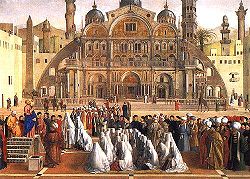Striking for its gleaming tones and stunning delicacy of line, the Seated Scribe is spectacular not only visually, but also in historiographic terms. The painting's original dimensions have been trimmed, and a later hand has taken care not only to embellish the image, but also to frame, mount, and, ultimately, historicize it. An added inscription in Persian records the image as the "work of Ibn Muezzin who was a famous painter among the Franks." Scholars have never doubted that a European or "Frankish" artist painted the Seated Scribe. The pressing issue of late has been who, precisely? Whether the Venetian Gentile Bellini, a renowned portraitist sent to Istanbul in 1479, or Costanzo da Ferrara, a court artist at Naples who also sojourned at the Porte, the specificity of detail in the Seated Scribe leaves little doubt that the artist drew from life.
Once the debate over attribution subsides, the more intriguing issue to raise is whether one can call the work a portrait. Might western pictorial realism have been the point of the exercise? A pronounced crease just above the youth's elbow suggests the image was initially handled as a loose-leaf, autonomous work of art before being mounted (and in this way preserved) in a sixteenth-century album. Like other western-style works Mehmed II commissioned or obtained during his sultanate, the Seated Scribe may have been used as a pedagogic tool for rising artists of the Ottoman royal workshop. A slightly later copy of the miniature (Freer Gallery of Art, Washington) certainly affirms its value for Ottoman and Persian artists as a pictorial model worthy of imitation. If the pictured youth is not a scribe but an artist, shown in the act of drawing while he himself is being drawn according to Western pictorial practices, the Seated Scribe taught by poignant example - it sits indeed at the nexus of Ottoman art and European traditions of representation.
Source: Susan Spinale, "A Seated Scribe," in Eye of the Beholder, edited by Alan Chong et al. (Boston: ISGM and Beacon Press, 2003): 97.Relevantní obrázky
Relevantní články
Gentile BelliniGentile Bellini se narodil do rodiny benátského malíře Jacopa Belliniho a jeho manželky Anny Rinversi. Otec mu dal jméno Gentile po svém učiteli a později i spolupracovníkovi Gentilem da Fabriano. Jeho mladším bratrem byl Giovanni Bellini a švagrem Andrea Mantegna. Nedávná publikace však naznačuje, že Giovanni byl nevlastním bratrem Jacopovým, nikoliv Gentileho. Po otcově smrti převzal vedení malířské dílny a stal se malířem benátských dóžat. Gentileho rozměrné obrazy měly charakter městských vedut. Tato plátna se vyznačovala velkým počtem postav a barevnou pestrostí. Stala se dokumentem společenského života v Benátkách na přelomu 15. a 16. století. .. pokračovat ve čtení








